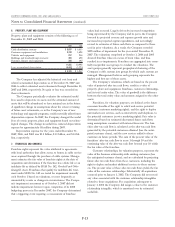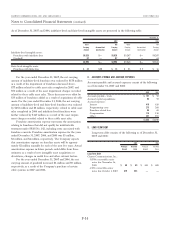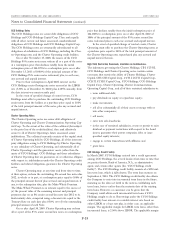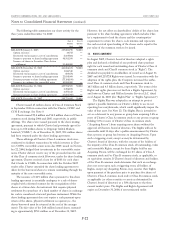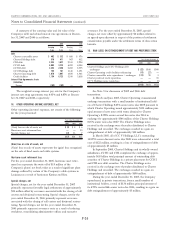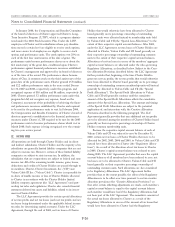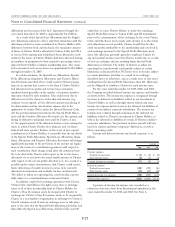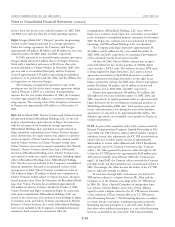Charter 2007 Annual Report Download - page 101
Download and view the complete annual report
Please find page 101 of the 2007 Charter annual report below. You can navigate through the pages in the report by either clicking on the pages listed below, or by using the keyword search tool below to find specific information within the annual report.
15. COMPREHENSIVE LOSS
The Company reports changes in the fair value of interest rate
agreements designated as hedging the variability of cash flows
associated with floating-rate debt obligations, that meet the
effectiveness criteria of SFAS No. 133, Accounting for Derivative
Instruments and Hedging Activities, in accumulated other compre-
hensive income (loss). Comprehensive loss for the years ended
December 31, 2007, 2006, and 2005 was $1.7 billion, $1.4 billion,
and $961 million, respectively.
16. ACCOUNTING FOR DERIVATIVE INSTRUMENTS AND HEDGING
ACTIVITIES
The Company uses interest rate derivative instruments, including
but not limited to interest rate swap agreements and interest rate
collar agreements (collectively referred to herein as interest rate
agreements) to manage its interest costs and reduce the Compa-
ny’s exposure to increases in floating interest rates. The Compa-
ny’s policy is to manage its exposure to fluctuations in interest
rates by maintaining a mix of fixed and variable rate debt within
a targeted range. Using interest rate swap agreements, the
Company agrees to exchange, at specified intervals through
2013, the difference between fixed and variable interest amounts
calculated by reference to agreed-upon notional principal
amounts.
The Company’s hedging policy does not permit it to hold
or issue derivative instruments for speculative trading purposes.
The Company does, however, have certain interest rate deriva-
tive instruments that have been designated as cash flow hedging
instruments. Such instruments effectively convert variable interest
payments on certain debt instruments into fixed payments. For
qualifying hedges, SFAS No. 133 allows derivative gains and
losses to offset related results on hedged items in the consoli-
dated statement of operations. The Company has formally
documented, designated and assessed the effectiveness of transac-
tions that receive hedge accounting. For the years ended Decem-
ber 31, 2007, 2006, and 2005, change in value of derivatives
includes gains of $0, $2 million, and $3 million, respectively,
which represent cash flow hedge ineffectiveness on interest rate
hedge agreements. This ineffectiveness arises from differences
between critical terms of the agreements and the related hedged
obligations.
Changes in the fair value of interest rate agreements that are
designated as hedging instruments of the variability of cash flows
associated with floating-rate debt obligations, and that meet the
effectiveness criteria specified by SFAS No. 133 are reported in
accumulated other comprehensive income (loss). For the years
ended December 31, 2007, 2006, and 2005, losses of $123 million
and $1 million, and a gain of $16 million, respectively, related to
derivative instruments designated as cash flow hedges, were
recorded in accumulated other comprehensive income (loss).
The amounts are subsequently reclassified as an increase or
decrease to interest expense in the same periods in which the
related interest on the floating-rate debt obligations affects earn-
ings (losses).
Certain interest rate derivative instruments are not desig-
nated as hedges as they do not meet the effectiveness criteria
specified by SFAS No. 133. However, management believes such
instruments are closely correlated with the respective debt, thus
managing associated risk. Interest rate derivative instruments not
designated as hedges are marked to fair value, with the impact
recorded as a change in value of derivatives in the Company’s
consolidated statement of operations. For the years ended
December 31, 2007, 2006, and 2005, change in value of deriva-
tives includes losses of $46 million, and gains of $4 million, and
$47 million, respectively, resulting from interest rate derivative
instruments not designated as hedges.
As of December 31, 2007, 2006, and 2005, the Company
had outstanding $4.3 billion, $1.7 billion, and $1.8 billion, and $0,
$0, and $20 million, respectively, in notional amounts of interest
rate swaps and collars, respectively. The notional amounts of
interest rate instruments do not represent amounts exchanged by
the parties and, thus, are not a measure of exposure to credit
loss. The amounts exchanged are determined by reference to the
notional amount and the other terms of the contracts.
17. FAIR VALUE OF FINANCIAL INSTRUMENTS
The Company has estimated the fair value of its financial
instruments as of December 31, 2007 and 2006 using available
market information or other appropriate valuation methodolo-
gies. Considerable judgment, however, is required in interpreting
market data to develop the estimates of fair value. Accordingly,
the estimates presented in the accompanying consolidated finan-
cial statements are not necessarily indicative of the amounts the
Company would realize in a current market exchange.
The carrying amounts of cash, receivables, payables and
other current assets and liabilities approximate fair value because
of the short maturity of those instruments. The Company is
exposed to market price risk volatility with respect to invest-
ments in publicly traded and privately held entities.
The fair value of interest rate agreements represents the
estimated amount the Company would receive or pay upon
termination of the agreements. Management believes that the
sellers of the interest rate agreements will be able to meet their
obligations under the agreements. In addition, some of the
interest rate agreements are with certain of the participating
banks under the Company’s credit facilities, thereby reducing the
exposure to credit loss. The Company has policies regarding the
financial stability and credit standing of major counterparties.
Nonperformance by the counterparties is not anticipated nor
would it have a material adverse effect on the Company’s
consolidated financial condition or results of operations.
The estimated fair value of the Company’s notes and
interest rate agreements at December 31, 2007 and 2006 are
based on quoted market prices, and the fair value of the credit
facilities is based on dealer quotations.
F-23
CHARTER COMMUNICATIONS, INC. AND SUBSIDIARIES 2007 FORM 10-K
Notes to Consolidated Financial Statements (continued)


